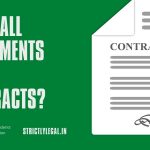The English classes must have taught you already that even a comma or a full-stop matters a lot, while drafting contracts.
Some of the rules on grammar and language style that you should keep in mind while drafting agreements.
To the extent possible, employ gender-neutral usage. E.g., instead of using “he shall perform the contract…”, you can use “the contractor shall perform the contract…”Second, many drafters in India have the habit of writing the names of parties in capital letters. This practice may be avoided because it drastically reduces the readability of the document. Instead, you could simply use the first letter of names or define terms in caps.Indian drafters also tend to use expressions such as “party of the first part”, “party of the second part”, etc. Again, these expressions substantially reduce readability and make their agreement look longer than it warrants. This phrase could simply be replaced with the names of the parties or their acronyms.Agreements with proper recitals go a long way in clarifying how the transaction came to be. These recitals also record the basic assumptions on which the transaction was entered into. In the coming chapters, I will be discussing in greater detail about recitals.Avoid unnecessary foreign words or archaic English. Usages such, witnesseth, doth covenant etc should be avoided.Use simple and clear language. Be cautious because the contra proferentem rule requires the court to construe an ambiguous contractual term against the drafter. So, if you draft the contract that contains an ambiguous term, the court will interpret it against you.Another thing is lawyers tend to be unnecessary prolix. Please avoid that habit. Try to form shorter sentences. Lengthy sentences terribly affect the readability.Also, avoid slang or informal words while drafting. You don’t say, “Party A will meet party B and give him the download.”Avoid legal doublets such as “good and sufficient cost”. And also legal triplets such as “ordered, adjudged and decreed”.In writing prose, elegant variation is appreciated. But in drafting agreements, elegant variation should be avoided. For instance, do not use the term “termination” in one place of the agreement and later use “cancellation” in another. Again, the expressions like “for the sake of clarity”, “it is made clear that” etc. should be avoided. These usages just may indicate that even the drafter held the view that the contractual term was vague in the first place. Other phrases like, “it must be noted that” can simply be shortened to “notably”, or “importantly”.Another suggestion is to capitalise the first letter of a term that is defined in the definition clause. This helps in distinguishing where the same word is used in the agreement but in a different context. Suppose a sentence reads, “The seller shall indemnify the buyer in respect of a suit by a third party.” Here though we would capitalise every instance of the word party in the agreement, we would not capitalise the word party while referring to a “third party”. The capitalisation also helps the reader while reading the agreement. It indicates to the reader that the capitalised word has to be read as in the light of the meaning given to it in the definition clause.
Use Active Voices instead of Passive voices
The next technique for better drafting is to use active voice rather than passive voice. Active voice is where the subject of the sentence performs an action. So when I say, “You should use active voice when drafting.” This is a sentence written in active voice. Here you, the subject, is asked to do something. But if I said, “active voice should be used by you”. That would be me saying the same thing in passive voice. Notice the difference, “used by you” versus “you should use”.
A good way to catch passive voice is often to look for the word “by”. If you have used the word “by” in a sentence you have written the sentence in passive voice. But this is only a quick trick and it may not always work. So, what are the advantages of writing in active voice?
A good way to catch passive voice is often to look for the word “by”. If you have used the word “by” in a sentence you have written the sentence in passive voice. But this is only a quick trick and it may not always work. So, what are the advantages of writing in active voice?
- For one, passive voice is generally longer and reduces readability.
Consider this sentence, “That confidential information will not be disclosed is undertaken by the supplier.” This sentence has 12 words in it. Instead, if I say, “The supplier undertakes not to disclose the confidential information.” Notice that this sentence is in active voice and it only employs 8 words.
- Second, passive voice can be vague. Take the sentence. “Both Othello and Lago desire Desdemona, she is courted.” But the sentence does not say, by whom? Or take another sentence, “Research has been done to discredit this theory.” And again the sentence does not say. Who did the research?
When you use active voice you are forced to say, who did what. To convert the sentence, “Research has been done to discredit this theory.” into active voice you would have to say something like, “Institution X conducted the research to discredit the theory.”
However, sometimes in the context of drafting agreements, passive voice can be useful. Especially where you wish to use neutral or less direct language. For instance, consider the phrases: (A) “The contract shall not be broken” and (B) “You shall not break the contract”.
Phrase (B) seems to be more in your face and can lead to a slight discomfort to the promisor, especially when you are negotiating a deal.
The long and short of it is, while it is normal to avoid passive voice in prose, it is often useful while drafting. To submit all up, use active voice unless you have good reason not to.
Passionate about using the law to make a difference in people’s lives. An Advocate by profession.





